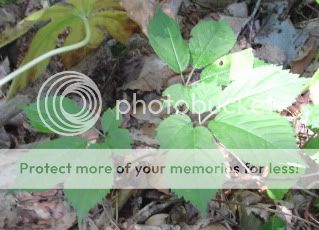WILD GINSENG SEED! GROW YOUR OWN!
 ">
">
ATTENTION WILD GINSENG HUNTERS; THE FUTURE OF WILD GINSENG DEPENDS ON YOU, AND YOU ALONE because you are the ones who roam the woods to find it, and only you know all it's secret places. Will you take the time to raise and plant the native seed in large enough quantities to make the difference?
MILK JUG GINSENG!
To raise your own wild ginseng seed, do the following;
(1) Take an empty gallon plastic milk jug and
(2) Cut up and over the handle, leaving the handle attached to the jug, then down to where the milk jug reaches its full width, then around the circumference of the jug and back up to where you started the cut. Then,
(3) Cut 2 holes about 1 inch up from the jug’s bottom, one on one corner and one on the opposite corner. Make the holes about 3/4 inches in diameter. These holes will allow drainage of excess water from the jug. The small reservoir below the holes will keep enough moisture in it so you will never have to water the plant. Next
(4) Fill the jug within 2 inches of the top with the same soil which wild ginseng grows in, and
(5) Plant a freshly dug wild ginseng root with all it's hair roots healthy and intact, and which has been harvested in the area where you live, in the jug, with the very top of the stem (where next year's bud forms) no further down than 1 inch below the surface. Then,
(6) Fill the jug on up with leaf mulch. When Autumn leaves begin to fall,
(7) Till up an area about 8 to 10 inches deep, and set all your planted jugs close together down in the tilled soil, as far as the top level of the soil in each of your jugs, in your tilled area, then cover your jugs with at least 3 feet of leaves, making sure that the outside circumference of the leaf pile is at least 5 feet away from the jugs. Cover the pile with fallen limbs or tarps to keep it from blowing away. If your ginseng is not protected in this manner, it is in grave danger of freezing and turning into mush the same way a potato does. Remember, the jugs are above ground and not protected as well as the wild plants which are in the ground are. (You can also bring them in the house and store them in your basement if it is not heated, and will not have temperatures below freezing or above 45 degrees F. -OR- If you have no basement or room to store the jugs, remove the roots from the jugs and store them in tightly sealed zip-lock bags in your refrigerator. DO NOT FREEZE THEM! Keep the temperature in your refrigerator between 38 to 45 degrees Fahrenheit. Leave your jugs outside until spring, then replant the refrigerated roots in them once more, for the coming growing season.) In the Spring,
(8) Remove the leaf pile from the jugs when the first wild ginseng plants in the area where you live are peeking out of the ground, carefully (so that you don't injure the emerging plants) remove excess leaves from the top of each jug, and distribute the jugs in properly shaded woods making sure that ground cover is not thick enough to help bugs get on your plants. Be sure to leave enough leaves and mulch in the top of each jug to discourage loss of moisture through evaporation. Then
(9) Keep your jugs weeded. If a spider decides to take up residence on your plant, do not disturb her. She will keep the insects thinned out. In the Fall,
(10) Gather the berries as they become scarlet, and plant them whole, without bruising, and in areas where ginseng will grow, by raising the leaves and leaf mold until you reach mineral soil. Gently place the berry on the soil and carefully cover it with the leaves and leaf mold, making sure that no air can reach it. The moisture in the berry will keep the seeds from drying out and perishing before the Fall rains come. This is Nature’s way and it is the most likely to give the seeds their best chance of surviving.
(11) By keeping your potted plants near each other, you will be improving their gene pool through pollination because you will have brought plants from your whole range into contact with each other, rather than leaving them to develop seed in the woods where they are only in contact with themselves or their closest relatives.The result should be a more hardy strain of native stock.
(12) If you follow these directions faithfully, you can expect to gather an average of 18 berries (35 seeds) per plant per season, You will need about 200 plants to harvest a pound of wild ginseng seed (which it would weigh if it were extracted from the berries). Each pound of ginseng seed will contain at least 6000 seeds. The berries you produce from 200 plants will keep you busy planting as they become ripe. Furthermore, the seed you produce will be perfect for your locality, since that is where it’s ancestors have always lived. Expect your potted plants to grow faster and larger than the wild ones which grow in the woods and must compete with the other plants, etc. Furthermore, you can move the jugs to the most favorable places in the woods, and if one of the plants shows some sign of disease, it can be easily removed from the presence of the others without disturbance. So far I have found no evidence of disease on any of my plants despite the fact that I use no fertilizer, insecticides or chemicals of any kind.
I have been raising wild seed in this manner for the past 6 years and have lost very few plants to the weather, etc., although occasionally one will become dormant for the season. The wild seeds which I grow from locally gathered wild ginseng have a much higher survival rate than commercially grown seeds which I have planted do.
I have deliberately avoided going into PH soil factors and other technical details for the simple reason that most ginseng gatherers, including myself, have already recognized how impractical it would be to test each little place in the woods where we dropped a few seeds. Even if we had all this information, we could do nothing about it except to either plant or not plant in that particular spot because if we did anything else we would not be producing the wild product and its value would be greatly diminished. Time will surely tell us whether one place is superior to another by the results each place yields. Thus we come to that old backwoods cut-and-try rule of thumb; “Do What Works, Quit What Don’t”. And that is what continuous process improvement is all about.
Notes; Deer are your worst enemy. They will eat the tops off your plants even if they are planted in a pot or milk jug. They can retard and eventually destroy your whole planting and growing effort if proper measures are not taken.
This is just one way of producing wild ginseng seed. The most important thing to do is grow wild ginseng seed in the way which works best for you. But please, please do it!
Here's how potted wild ginseng looks;

by Fred Gates, A friend of Wild Ginseng.
 ">
">FRED GATES"
(Mr. Wild Spirit Ginseng)
Free counters provided by Andale.

Happy 'Sanging!